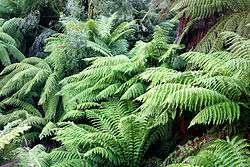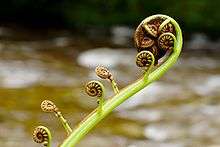Cyatheales
| Tree fern (Cyatheales) | |
|---|---|
 | |
| Dicksonia antarctica | |
| Scientific classification | |
| Kingdom: | Plantae |
| Division: | Pteridophyta |
| Class: | Polypodiopsida / Pteridopsida (disputed) |
| Order: | Cyatheales |
| Families and Genera | |
The order Cyatheales, which includes the tree ferns, is a taxonomic division of the fern class, Polypodiopsida.[1] No clear morphological features characterize all of the Cyatheales, but DNA sequence data indicate the order is monophyletic. Some species in the Cyatheales have tree-like growth forms, but others have rhizomes. Some species have scales on the stems and leaves, while others have hairs. However, most plants in the Cyatheales are tree ferns and have trunk-like stems up to 10 metres (33 ft) tall. It is unclear how many times the tree form has evolved and been lost in the order.[2]
Description
In general, any fern that grows with a trunk elevating the fronds (leaves) above ground level can be called a tree fern. However, the plants formally known as tree ferns comprise a group of large ferns belonging to the families Dicksoniaceae and Cyatheaceae in the order Cyatheales.
Tree ferns are found growing in tropical and subtropical areas, as well as temperate rainforests in South Africa, Australia, New Zealand, and other island groups nearby; a few genera extend further, such as Culcita in southern Europe. Like all ferns, tree ferns reproduce by means of spores developed in sporangia on the undersides of the fronds.

The fronds of tree ferns are usually very large and multiple-pinnated, but at least one type has entire (undivided) fronds. The fronds of tree ferns also exhibit circinate vernation, meaning the young fronds emerge in coils that uncurl as they grow.
Unlike flowering plants, tree ferns do not form new woody tissue in their trunk as they grow. Rather, the trunk is supported by a fibrous mass of roots that expands as the tree fern grows.
Some genera — for example Dicksonia and Cibotium, and some Cyathea — can be transplanted by severing the top portion from the rest of the trunk and replanting it. If the transplanted top part is kept moist it will regrow a new root system over the next year. The success rate of transplantation increases if the roots are dug up intact. If the crown of the Tasmanian tree fern Dicksonia antarctica (the most common species in gardens) is damaged, it will die because all new growth occurs there. But other clump-forming tree fern species, such as D. squarrosa and D. youngiae, can regenerate from basal offsets or from "pups" emerging along the surviving trunk length. Tree ferns often fall over in the wild, yet manage to reroot from this new prostrate position and begin new vertical growth.

The number of tree fern species is likely to be around a thousand. Although new species are discovered in New Guinea with each botanical survey, many species throughout its range have become extinct in the last century as forest habitats have come under pressure from human activity.
Threats to tree ferns
While many ferns are able to achieve a widespread distribution because of their spore reproduction, tree fern species tend to be very local. This makes their species much more susceptible to the effects of local deforestation. Why species are not more widespread is unknown, especially considering they have sufficient height to have a greater chance of getting spores into the wind stream.
Where feral pigs are a problem, as in some Hawaiian rainforests, they will knock over tree ferns to root out the starchy pith, killing the plant.[3]

Non-Cyatheales tree ferns
Outside of the Cyatheales a few ferns in other groups could be considered tree ferns, such as several ferns in the family Osmundaceae that can achieve short trunks under 1 metre (3.3 ft) tall. A few species in the genera Blechnum, Leptopteris, Sadleria and Todea could also be considered tree ferns in a liberal interpretation of the term.
The families that constitute Cyatheales have been relatively firmly established as a clade by DNA sequencing and morphological studies. The order Plagiogyriales, which contains the family Plagiogyriaceae, is most closely related to the Cyatheales, not to the Osmundales as had been previously supposed.


Phylogeny
The following phylogram shows a possible relationship between the Cyatheales families and their genera.[1][4][5]
| |
| |||||||||||||||||||||||||||||||||||||||||||||||||||||||||||||||||||||||||||||||||||||||||||||||||||||||||||||||||||||||||||||||||
| |
References
- 1 2 P. Koral et al. 2007 Petra Korall, David S. Conant, Jordan S. Metzgar, Harald Schneider, Kathleen M. Pryer: "A Molecular phylogeny of scaly tree ferns (Cyatheaceae)." American Journal of Botany 94(5): (2007) 873–886
- ↑ Judd, W.S., C.S. Campbell, E.A. Kellogg, P.F. Stevens, and M.J. Donoghue (Eds.) 2008. Plant Systematics: A Phylogenetic Approach, Third Edition. Sinauer Associates, Sunderland, Massachusetts, USA.
- ↑ Baskin, Yvonne (2003). A Plague of Rats and Rubbervines: The Growing Threat of Species Invasions. Island Press. pp. 74–75. ISBN 978-1-55963-051-1.
- ↑ P. Koral et al. 2006 Petra Korall, Kathleen M. Pryer, Jordan S. Metzgar, Harald Schneider, David S. Conant: "Tree ferns: Monophyletic groups and their relationships as revealed by four protein-coding plastid loci." Molecular Phylogenetics and Evolution 39 (2006) 830–845
- ↑ S. Lehtonen 2011 Samuli Lehtonen: "Towards Resolving the Complete Fern Tree of Life" PLoS ONE 6(10): e24851. doi:10.1371/journal.pone.0024851 PMID 22022365 (13 Oct 2011)
- Pryer, K.M., A.R. Smith, and J.E. Skog. 1995. Phylogenetic relationships of extant ferns based on evidence from morphology and rbcL sequences. American Fern Journal 85: 205-282.
- C.Michael Hogan. 2010. Fern. Encyclopedia of Earth. National council for Science and the Environment. Washington, DC
- Large, M.F. and J.E. Braggins Tree Ferns. Timber Press (2004).
- Smith, A.R., K.M. Pryer, E. Schuettpelz, P. Korall, H. Schneider & P.G. Wolf 2006. A classification for extant ferns. PDF (420 KiB) Taxonomy 55(3): 705-731.
External links
- Community: Care and propagation of Treeferns (German/English)
- Fern Files: Tree Ferns
| Wikimedia Commons has media related to Cyatheales. |